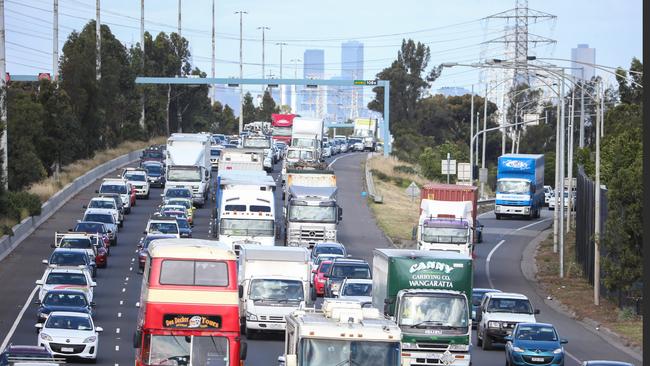How bad policy led to cities congestion

COMMENT
Large cities such as Melbourne and Sydney will always face some congestion. But our big cities today are suffering more than they should due to decisions made more than a decade ago.
Two things occurred, which we are now just catching up on.
First, the population growth rate for our nation (and particularly our big cities) was turbo charged in 2007 due to the Rudd Government massively increasing the immigration rate.
This put our population growth into the fast lane, but particularly the growth of our big three urban areas: Melbourne, Sydney and South East Queensland which received 75 per cent of all the growth. They have been among the fastest growing cities in the OECD.
Critically, however, it put our growth rate well above the projections. For example, the 2002 Intergenerational Report predicted Australia would grow by about 2.5 million over the last 15 years. We actually grew by 5 million.
Between 2004 and 2017, Melbourne was projected by the ABS to grow by 500,000. It grew by 1.2 million.
This mismatch between projections and actual population growth has made it more challenging for governments at all levels to appropriately plan for and invest early in the essential infrastructure needed. This is particularly the case given the long lead times to plan and construct major urban infrastructure projects.
Second, there was insufficient infrastructure built in the early 2000s, particularly in Melbourne and Sydney, to cater for forecast growth, let alone the actual growth. Former NSW Labor Premier, Bob Carr, for example famously said that “Sydney is full” and used it as a reason to doze off and not build for the future. Melbourne has had the fastest growth of any city but slammed the breaks on congestion-busting projects such as the East West Link.
We have been in catch-up phase since. Total government expenditure on infrastructure has increased markedly - greatly assisted by the federal Coalition in the last five years. Sydney, particularly, is being transformed and in a couple of years’ time, will flow much more smoothly.
We need to learn from past mistakes and take leadership to ensure there is a better future ahead. This is exactly what the Coalition Government has been doing, and Prime Minister Morrison’s bringing together of population, infrastructure and cities policy is a key part of this.
Our plan consists of four parts.
• Part one is a massive boost in infrastructure expenditure to build the major intra-city road and rail networks. This Government increased expenditure as soon as we came to office and in the last budget, allocated a record $75 billion with forward 10-year plans.
We have worked alongside state and local governments to ensure that critical pieces of these networks are completed. We also continue to commit federal money to projects we believe just have to be built, even where state governments disagree. An example of this is the East West Link in Victoria where the federal government has earmarked $3 billion ready to contribute if the project becomes a reality.
• Part two is to address quickly the very local congestion bottle-necks. The focus of infrastructure expenditure is frequently on the major national or city corridors, but sometimes it is local bottle-necks that causes the greatest delays for commuters. We have allocated a billion dollars to address these problems.
• Part three is to ease the population pressure off the three big cities and more rapidly grow the smaller states and regions.
The primary population challenge for Australia is that our growth is not evenly distributed. We have very fast population growth in Melbourne, Sydney and South East Queensland. But at the same time, we have the smaller cities and many regional areas that have barely grown and crying out for more people. Last year, for example, Adelaide grew by 10,000 people. Melbourne grew by 10,000 every 28 days.
Because migration has been such a huge contributor to the population growth of Melbourne and Sydney (64 per cent and 84 per cent respectively), directing even a slightly larger proportion of newly arrived migrants to the smaller cities or regions can take significant pressure off our big cities. At the same time, this would support the growth aspirations of those other areas. There is nothing radical about this approach; we already do it successfully, but on a small scale, through the 489 Visa program.
This would work in tandem with our lower permanent migration intake, which last year was the lowest in more than a decade.
We can also better connect and integrate our orbital cities. If a person in Ballarat, for example, can commute to Melbourne in 45 minutes rather than the present 75, then the opportunities for Ballarat’s growth would accelerate markedly.
• The fourth element of our plan is to have a better population planning framework. One of the challenges of our federation is that the primary population levers are set at the federal level, while the states have the primary responsibility for implementing the transport infrastructure and government services to cater for the growth.
We will be developing a process which has better engagement with the states on a more regular and systemic basis to determine population objectives for each region and better align federal and state infrastructure expenditure to support these objectives.
Australia has some of the greatest cities in the world. But to maintain their liveability, we have to learn the lessons of the past and properly invest and plan for the future.
Alan Tudge is the Minister for cities, urban infrastructure and population



